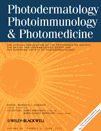
PHOTODERMATOLOGY PHOTOIMMUNOLOGY & PHOTOMEDICINE
Scope & Guideline
Illuminating the Intersection of Skin Health and Science
Introduction
Aims and Scopes
- Photodynamic Therapy (PDT):
The journal publishes extensively on photodynamic therapy, which combines light with photosensitizing agents to treat various skin conditions, including skin cancers, acne, and psoriasis. - Photoprotection and Sun Safety:
Research on sun protection measures, including the efficacy of sunscreens and public health strategies to promote sun-safe behaviors, is a core focus. - Photobiomodulation:
Studies on the therapeutic effects of low-level light therapy for conditions like wound healing and hair loss are highlighted, emphasizing its role in dermatological treatments. - Skin Cancer and Photodermatoses:
The journal addresses skin cancer prevention, diagnosis, and treatment, particularly focusing on the role of ultraviolet light in skin carcinogenesis. - Innovative Dermatological Treatments:
Research on novel treatments for skin conditions, including the use of lasers, light-emitting diodes, and other innovative technologies, is frequently featured. - Microbiome and Skin Health:
Emerging studies on the relationship between the skin microbiome and photodermatology, particularly regarding skin aging and photodamage, are gaining traction.
Trending and Emerging
- Integration of Artificial Intelligence (AI):
The trend towards incorporating AI in dermatology for diagnostic purposes and treatment predictions is emerging, showcasing the intersection of technology and phototherapy. - Personalized Photoprotection:
Research is increasingly focusing on tailored photoprotection strategies, particularly for diverse skin types and conditions, highlighting the need for individualized approaches. - Impact of Ultraviolet Radiation on Systemic Health:
There is growing interest in studies examining how ultraviolet radiation affects not just skin but also systemic conditions, including cardiovascular health and immune responses. - Role of the Skin Microbiome:
Investigations into how the skin microbiome interacts with light exposure and its implications for skin health and disease are becoming a focal point in recent publications. - Long-term Effects of Phototherapy:
Emerging studies are exploring the long-term effects of various phototherapy treatments on skin health, including safety and efficacy over extended periods.
Declining or Waning
- Traditional Sunscreen Studies:
There has been a noticeable decline in studies focused solely on traditional sunscreen formulations, as research shifts towards more comprehensive assessments of sun protection strategies. - Isolated Case Reports:
The frequency of isolated case reports, particularly those without significant new findings, seems to be decreasing, indicating a movement towards more rigorous clinical studies and systematic reviews. - Non-Phototherapy Related Conditions:
Research unrelated to phototherapy, such as general dermatological conditions without a phototherapeutic angle, is less frequently published, reflecting the journal's specialized focus.
Similar Journals

Journal of Cutaneous Immunology and Allergy
Transforming understanding of immune-mediated skin disorders.The Journal of Cutaneous Immunology and Allergy, published by FRONTIERS MEDIA SA in Switzerland, is an esteemed Open Access platform dedicated to advancing research in the intersecting fields of dermatology, immunology, and allergy. Since its inception in 2018, this journal has provided a vital resource for the dissemination of innovative research findings and critical reviews, enhancing our understanding of cutaneous conditions related to immune responses. Although currently classified in the Q4 quartile in both Dermatology and Immunology & Allergy categories as of 2023, the journal continues to strive for recognition within the scientific community, encouraging collaboration and knowledge sharing among researchers, clinicians, and experts. The journal boasts an E-ISSN of 2574-4593 and is committed to making high-quality research freely accessible to all, thus fostering greater insights into the complexities of skin-related immune disorders. Join us in this journey to explore the forefront of cutaneous research and contribute to the evolving dialogue in this dynamic field.
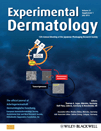
EXPERIMENTAL DERMATOLOGY
Exploring New Frontiers in DermatologyEXPERIMENTAL DERMATOLOGY, published by WILEY, is a leading journal in the fields of Biochemistry and Dermatology, with impressive rankings including Q1 status in both categories as of 2023. With its ISSN 0906-6705 and E-ISSN 1600-0625, the journal offers a reputable platform for disseminating cutting-edge research and insights into skin biology and related health issues. As a pivotal resource for professionals, researchers, and students alike, EXPERIMENTAL DERMATOLOGY includes a broad scope of topics, fostering a deeper understanding of dermatological conditions and enhancing new therapeutic strategies. The journal’s distinguished performance is highlighted by its Scopus rankings, which place it at the 91st percentile in Medicine-Dermatology and the 65th in Biochemistry. While not an open-access publication, the journal remains committed to ensuring the accessibility of crucial developments within the dermatological community worldwide, facilitating the advancement of both clinical practice and academic inquiry.

VETERINARY DERMATOLOGY
Leading the way in veterinary dermatology research and practice.Veterinary Dermatology is a prestigious peer-reviewed journal dedicated to advancing the field of veterinary dermatology, published by Wiley. With a longstanding commitment to disseminating high-quality research since its inception in 1990, this journal has garnered significant recognition, achieving a commendable Q1 ranking in the Veterinary (miscellaneous) category for 2023 and ranking #42 out of 194 in the General Veterinary category on Scopus, placing it within the 78th percentile. Although it operates primarily on a subscription basis, the journal offers vital insights into the latest developments, clinical practices, and case studies in veterinary skin disorders. By serving as a crucial platform for researchers, veterinary professionals, and students, Veterinary Dermatology empowers its audience with the knowledge necessary to enhance animal healthcare and well-being across diverse environments. With its focus on cutting-edge research and its contribution to the global veterinary community, this journal remains an indispensable resource for those dedicated to the field.
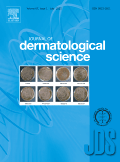
JOURNAL OF DERMATOLOGICAL SCIENCE
Unveiling the Science Behind Skin HealthThe Journal of Dermatological Science is a premier peer-reviewed publication dedicated to advancing knowledge in the field of dermatology, biochemistry, and molecular biology. Established in 1990 and published by Elsevier Ireland Ltd, this esteemed journal has consistently achieved high academic recognition, securing a Q1 ranking in Dermatology and a Q2 ranking in both Biochemistry and Molecular Biology as of 2023. With a notable impact factor and a Scopus rank that places it within the top tier of dermatology journals globally, it serves as a critical platform for researchers, clinicians, and academicians to disseminate their findings and foster innovation in skin health and disease management. Although the journal is not open access, it provides essential insights into cutting-edge research, clinical practices, and molecular mechanisms underlying dermatological conditions. The Journal of Dermatological Science is not only a vital resource for high-quality articles but also a driving force in shaping the future landscape of dermatological research.

CUTIS
Exploring innovative treatments in dermatology.CUTIS is a distinguished journal devoted to advancing the field of dermatology and related medical disciplines. Published by Quadrant HealthCom Inc, this journal has been a critical resource since its inception in 1970, traversing the landscape of skin health and medical practice through its engaging articles and research. With an ISSN of 0011-4162 and an E-ISSN of 2326-6929, CUTIS is indexed in Scopus, where it currently holds a rank of #101/142 in the Dermatology category, placing it in the 29th percentile, further affirming its relevance within the academic community. Although it is classified within the Q3 quartile in both Dermatology and Medicine (miscellaneous), CUTIS remains committed to publishing high-quality research that encompasses both innovative treatments and essential dermatological knowledge. The journal serves as an invaluable platform for researchers, practitioners, and students alike, providing critical insights and fostering discussions that enhance patient care and professional practice in the dermatology field.

SKIN PHARMACOLOGY AND PHYSIOLOGY
Advancing Insights in Skin Health and PharmacologySKIN PHARMACOLOGY AND PHYSIOLOGY is a leading peer-reviewed journal published by KARGER, based in Switzerland, that focuses on the intricate interplay between skin pharmacology and physiology. With its ISSN 1660-5527 and E-ISSN 1660-5535, the journal spans a rich history of publication since 1988, presenting groundbreaking research and discoveries in the fields of dermatology, pharmacology, and physiology. As evidenced by its 2023 quartile rankings, which include Q2 in Dermatology and Q2 in Medicine (miscellaneous), this journal is highly regarded, ranking in the 83rd percentile for dermatology in Scopus, reflecting its significant impact on the scientific community. Researchers, professionals, and students alike will find valuable insights in this publication, which aims to disseminate knowledge and foster innovations that enhance the understanding of skin-related health. The open access policies provide wider accessibility to relevant findings and developments, making it an essential resource for anyone dedicated to advancing the field.
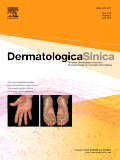
Dermatologica Sinica
Exploring the Frontiers of Dermatology TogetherDermatologica Sinica, published by Wolters Kluwer Medknow Publications, is an esteemed open-access journal in the field of dermatology that has been disseminating critical research since its inception in 2005. With an E-ISSN of 2223-330X and an ISSN of 1027-8117, this journal presents a platform for researchers, clinicians, and students to share cutting-edge findings and advancements in dermatological science. As of 2023, it proudly ranks in the Q2 category of dermatology journals and holds a notable position at rank #62 out of 142 in the Scopus Medicine - Dermatology category, placing it in the 56th percentile for impact. The journal transitioned to an open-access model in 2016, enhancing accessibility and visibility for groundbreaking studies worldwide. With a commitment to fostering innovation in the dermatological community, Dermatologica Sinica aims to advance the understanding and treatment of skin diseases while encouraging scholarly dialogue among practitioners and researchers across the globe.
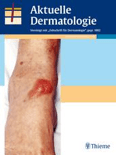
AKTUELLE DERMATOLOGIE
Pioneering Research in the World of DermatologyAKTUELLE DERMATOLOGIE is a distinguished journal in the field of Dermatology, published by GEORG THIEME VERLAG KG in Germany. With a commitment to advancing knowledge and practice in dermatological science, the journal has regularly featured research articles, reviews, and case studies since its inception in 1975 and continues to publish contributions through 2024. Despite being categorized in the lower quartile (Q4) of dermatology journals and holding a Scopus rank of #127 out of 142, it plays a pivotal role in disseminating valuable insights that support ongoing education and research in the discipline. The journal provides an essential platform for both seasoned professionals and budding researchers to share their findings, explore emerging trends, and discuss clinical practices, all while serving the needs of an evolving medical landscape. Access to its content may be restricted, but the journal remains a crucial reference for those invested in the future of dermatological research and patient care.

AUSTRALASIAN JOURNAL OF DERMATOLOGY
Fostering scholarly dialogue in skin health.Australasian Journal of Dermatology is a leading publication in the field of dermatology, issued by Wiley since 1951, and reaching an audience of researchers, clinicians, and students interested in the latest advancements and practices in skin health. With an ISSN of 0004-8380 and an E-ISSN of 1440-0960, this journal stands out with its Q2 ranking in both Dermatology and Miscellaneous Medicine, positioning it within the top 61st percentile of its category according to Scopus. Although it does not provide Open Access options, Australasian Journal of Dermatology is committed to disseminating high-quality research that informs clinical practices and promotes scholarly dialogue. By publishing rigorous and peer-reviewed articles focused on various aspects of dermatological science, the journal plays a pivotal role in enhancing the dermatology community's understanding of skin conditions and treatments, making it an invaluable resource for professionals and students alike.
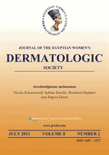
Journal of Egyptian Womens Dermatological Society
Elevating Women's Voices in Dermatological ScienceThe Journal of Egyptian Women's Dermatological Society, published by Wolters Kluwer Medknow Publications, is an essential platform dedicated to advancing the field of dermatology through a valuable focus on women's health issues. Established to provide an open access outlet since 2019, this journal aims to disseminate research, case studies, and reviews that address the unique dermatological needs and concerns of women, particularly in the Egyptian context. Despite its current ranking in the Q4 category in dermatology and a Scopus rank of #117 out of 142 with a 17th percentile, the journal serves a critical role in fostering scholarly communication among researchers, clinicians, and academicians. With a commitment to promoting knowledge advancement and community engagement, this journal invites submissions that align with its objectives, specifically geared towards empirical research and innovative practices in dermatology impacting women's health.